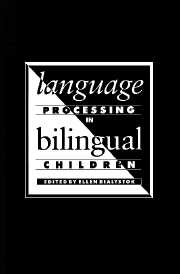Book contents
- Frontmatter
- Contents
- List of figures
- List of tables
- List of contributors
- Preface
- Introduction
- 1 Language modules and bilingual processing
- 2 Phonological processing in two languages
- 3 Second-language learning in children: a model of language learning in social context
- 4 Interdependence of first- and second-language proficiency in bilingual children
- 5 Giving formal definitions: a linguistic or metalinguistic skill?
- 6 Metalinguistic dimensions of bilingual language proficiency
- 7 Translation skill and metalinguistic awareness in bilinguals
- 8 Towards an explanatory model of the interaction between bilingualism and cognitive development
- 9 Constructive processes in bilingualism and their cognitive growth effects
- 10 Language, cognition, and education of bilingual children
- Index
4 - Interdependence of first- and second-language proficiency in bilingual children
Published online by Cambridge University Press: 11 January 2010
- Frontmatter
- Contents
- List of figures
- List of tables
- List of contributors
- Preface
- Introduction
- 1 Language modules and bilingual processing
- 2 Phonological processing in two languages
- 3 Second-language learning in children: a model of language learning in social context
- 4 Interdependence of first- and second-language proficiency in bilingual children
- 5 Giving formal definitions: a linguistic or metalinguistic skill?
- 6 Metalinguistic dimensions of bilingual language proficiency
- 7 Translation skill and metalinguistic awareness in bilinguals
- 8 Towards an explanatory model of the interaction between bilingualism and cognitive development
- 9 Constructive processes in bilingualism and their cognitive growth effects
- 10 Language, cognition, and education of bilingual children
- Index
Summary
When children begin the acquisition of a second language (L2), whether in the home or at school, their cognitive resources clearly play a central role in the rapidity and ultimate success with which that language is acquired. Other individual factors, such as motivation, and contextual factors that determine amount and type of exposure to the second language, are also central to the acquisition process and in most situations are likely to interact with cognitive factors. I argue in this chapter that the process of second-language acquisition can be clarified by distinguishing between two dimensions of proficiency that relate in specific ways to determinants of the acquisition process, namely, attribute-based and input-based aspects of proficiency.
Attribute-based aspects of proficiency refer to those dimensions of proficiency whose acquisition is strongly influenced by relatively stable attributes of the individual learner, for example, cognitive and personality variables. Input-based aspects of proficiency, on the other hand, are considerably less related to stable attributes of the individual than they are to the quality and quantity of L2 input received from the environment. In the initial stages of acquiring the L2 the distinction between attribute- and input-based dimensions of proficiency may not be apparent but, over time, the distinctive influences of attributes and input will result in differentiation between these dimensions.
- Type
- Chapter
- Information
- Language Processing in Bilingual Children , pp. 70 - 89Publisher: Cambridge University PressPrint publication year: 1991
- 347
- Cited by



